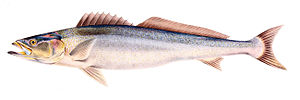African umberfish
| African umberfish | ||||||||||||
|---|---|---|---|---|---|---|---|---|---|---|---|---|

African umberfish ( Atractoscion aequidens ) |
||||||||||||
| Systematics | ||||||||||||
|
||||||||||||
| Scientific name | ||||||||||||
| Atractoscion aequidens | ||||||||||||
| ( Cuvier , 1830) | ||||||||||||
The African umber fish ( Atractoscion aequidens ) is a species of fish from the family of umber fish (Sciaenidae). It occurs off the south coast of Africa from Angola via South Africa to Mozambique and off the east coast of Australia . The species is fished commercially as well as by sport fishermen and is freshly marketed.
features
African umberfish are elongated, powerful fish that can reach a length of up to 130 cm and a weight of up to 25 kg. They are bluish to copper in color with a silvery sheen and a whitish belly. The mouth is large and terminal with several rows of needle-like teeth of uniform size. The inside of the mouth and the gill cover is strikingly yellow, which is why the species is called geelbeek (yellow mouth) in Afrikaans . There are 75 ctenoid scales along the sideline . The fins are translucent gray. The dorsal fin is divided by a clear notch into a front part with nine to 10 hard rays and a rear part with one hard and 25 to 32 soft rays. The anal fin has two hard and nine to ten soft rays. The caudal fin is notched. The gill trap has 12 to 16 thorns on the first arch. The swim bladder has a single pair of attachments.
Way of life
The species lives in coastal waters over sandy bottoms to a depth of around 200 meters. It forms schools that are mostly close to the ground. The animals are fast, nocturnal hunters who chase fish swimming in the pelagic area even to the surface of the water. Young animals often stay in estuaries .
swell
- Rudy Van Der Elst, Peter Borchert: Guide to the Common Sea Fishes of South Africa . 3. Edition. Struik Publishers, 1994, ISBN 978-1-86825-394-4 , pp. 290 .
- African Umberfish on Fishbase.org (English)